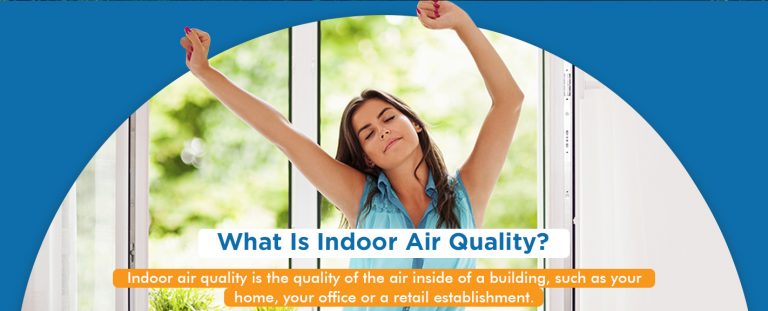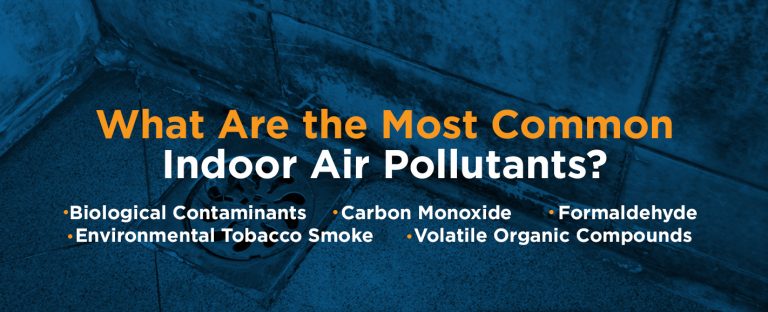Keep The Flu and Other Viruses Out Of Your Home
We are in peak flu and virus season – but just because people around you are getting sick, doesn’t mean you have to get sick, too. There is an easy way to keep virus particles and germs out of your home to help prevent you and your family from getting sick. Indoor Air Quality products (sometimes referred to as IAQ) can help clean the air as it circulates throughout your home, allowing you to breathe cleaner air. These products can remove things like virus particles, dust, bacteria, fungi, pollen, and pet dander.
But how effective are our Indoor Air Quality systems? VERY effective! Our IAQ products can:
- Trap 99% of airborne pollen, mold and spore-sized particles
- Eliminate 98% of airborne bacteria-sized particles
- Remove 94% of respiratory dust, which the EPA reports can trigger asthma
- Capture 80% of airborne particles the size of tobacco smoke
- Remove up to 80% of airborne virus-sized particles - something no other air cleaner in the industry can do
What Is Indoor Air Quality?
Indoor air quality is the quality of the air inside of a building, such as your home, your office or a retail establishment. Indoor air quality is different from outdoor air quality as well as from air quality in an industrial setting, such as a factory or power plant.
Multiple factors can affect the quality of the air inside your home:
- Temperature
- Humidity levels
- Ventilation
- Chemicals and particles in the air
- Mold growth

Did you know: The air in your home can be up to 5 times more polluted than the outdoor air?
The quality of the air inside of your home where you spend a lot of time can have a considerable impact on your health. Often, the health issues that result from poor indoor air quality are called “sick building syndrome” (SBS). The signs of SBS usually clear up once a person leaves the building.

Request My Free Estimate
What Causes Poor Indoor Air Quality?
A variety of factors influence the overall air quality inside of a building. Some of the causes of poor indoor air quality include:
- Poor Ventilation. If the heating or cooling system in a building is not maintained or is not functioning correctly, it might cause dusty air to circulate through the home or building. A building or house that does not have working windows or that does not get a supply of "fresh air" regularly is also likely to have poor indoor air quality.
- Off-gassing of chemicals from paint, furniture and other materials. The materials you are likely to find in a building, such as a carpet on the floor or the paint on the walls, consistently release pollutants or volatile organic compounds.
- Activities inside the building. Some cleaning products create fumes or contain fragrances that can lower the indoor air quality of a building. Certain activities, such as burning incense or smoking cigarettes indoors can also lower the quality of the air by introducing particulates into the air.
- External pollutants and contaminants brought indoors. If a building is near a source of outdoor pollution, such as a smokestack, there is the chance that contaminants and particulates from that source can make their way into the building.
- Pets and pests inside the home. If you live with animal companions, their dander and fur can affect the quality of the air in your home. Pet dander can be a particular concern if you have allergies. Additionally, if you have uninvited animal guests in your house, such as mice or cockroaches, their droppings also contribute to reduced indoor air quality.
- High humidity levels. If the air inside of your home is damp or humid, there is an increased risk of mold growth, which can affect the quality of the air. A humid home can also be a hospitable environment for bacterial growth.
What Are the Most Common Indoor Air Pollutants?
The types of pollutants that affect indoor air quality can vary based on what’s inside of a home or building and what can get inside of a structure. Although there is a long list of pollutants that can impact the quality of the air inside your home, if you do have poor indoor air quality, it is likely that one or more of the following is to blame.

Biological Contaminants
Multiple pollutants fall under the category of "biological contaminants." What they have in common is that they come from a living source. For example, mold and bacteria are two examples of biological contaminants. Pet dander and saliva can also contribute to reduced indoor air quality, especially if you have allergies. The droppings and urine (which can become airborne when it dries) produced by cockroaches, mice and other household pets also fall into this category. Certain conditions inside of a house can create an environment that's hospitable for biological contaminants. Damp or wet areas can lead to the growth of mold, bacteria and mildew and dust mites also thrive in wet or damp conditions. Keeping the humidity levels in your home between 30 and 50 percent is one way to reduce the risk of pollution from biological contaminants. Controlling any pests, such as by catching mice or roaches and by keeping food and water out of their reach can also help.
Carbon Monoxide
Carbon monoxide (CO) can be a tricky and dangerous source of indoor air pollution. It is a gas that is colorless and odorless, so it can be difficult to detect without a carbon monoxide alarm. The effects of CO on a person's health vary based on the levels of the gas inside a building. At low levels, it might make you feel tired. At higher levels, it can cause confusion, headaches and flu-like symptoms. Potential sources of CO include:
- Appliances: Gas stoves, charcoal grills, clothes dryers, water heaters, furnaces, space heaters and gas fireplaces
- Smoke: Tobacco smoke from cigarettes and cigars, wood-burning fireplaces and charcoal grills
- Power Tools: Chainsaws, gas lawnmowers, gas-powered tools One way to keep CO levels inside of your home within the recommended levels is to have your heating system inspected regularly. It is also a good idea to install a carbon monoxide detector with an alarm so that you know if CO levels become elevated.
Formaldehyde
Formaldehyde is another type of colorless gas. It is produced as a result of combustion and is found in tobacco smoke as well as the emissions produced by fuel-burning heating systems. Certain products found in buildings and homes can also contain formaldehyde. These products, such as furniture made from particleboard or compressed wood, can "off-gas" formaldehyde, especially in hot conditions. Ways to avoid or reduce exposure to formaldehyde include choosing furniture made from materials that comply with ANSI/HPVA HP-1-2009, ANSI A208.1-2009 or ANSI A208.2-2009 standards. If you are not sure of the materials used in your furniture, keeping your home well ventilated will allow formaldehyde to dissipate.
Environmental Tobacco Smoke
Smoking tobacco products inside a home or building reduces indoor air quality in a couple of ways. Tobacco smoke produces both CO and formaldehyde. It also contains approximately 7,000 other substances. The best way to limit exposure to the pollutants found in tobacco smoke, both for the person who smokes and others in the home, is to avoid smoking indoors.
Volatile Organic Compounds
A volatile organic compound (VOC) is a gas that is released into the air by a product. Formaldehyde is an example of a VOC. Levels of VOCs are often are 10 times higher in indoor environments compared to outdoor environments. A wide range of products found in homes and other buildings can produce VOCs:
- Paint
- Cleaning products
- Carpeting
- Laminate flooring
- Air fresheners
- Pesticides
- Glue
- Dry cleaning solutions (found on dry cleaned clothing)
- Permanent markers
- Cosmetics
What Are the Effects of Indoor Air Quality on Your Health?
 Pollutants that affect indoor air quality can also affect your health. In rare cases, poor indoor air quality can lead to specific diseases, such as Legionnaire’s disease. In other instances, you might have symptoms and feel ill effects because of poor air quality, but you might not be able to put your finger on a specific illness.
The effects of indoor air quality on your health can be immediate, meaning they develop right away after exposure to a particular pollutant. These effects can also be long-term, which means it can take years for symptoms to develop, or you need repeated exposure to the contaminant to notice any ill effects.
Some of the immediate health effects of poor indoor air quality include:
Pollutants that affect indoor air quality can also affect your health. In rare cases, poor indoor air quality can lead to specific diseases, such as Legionnaire’s disease. In other instances, you might have symptoms and feel ill effects because of poor air quality, but you might not be able to put your finger on a specific illness.
The effects of indoor air quality on your health can be immediate, meaning they develop right away after exposure to a particular pollutant. These effects can also be long-term, which means it can take years for symptoms to develop, or you need repeated exposure to the contaminant to notice any ill effects.
Some of the immediate health effects of poor indoor air quality include:
- Headaches
- Dizziness
- Fatigue
- Irritation to the eyes, throat or nose
- Difficulty breathing (asthma symptoms)
- Memory trouble
- Stuffy or runny nose
How Do You Know If Your Indoor Air Is Unhealthy?
There are a few ways to tell if the air inside your home is unhealthy. The first thing to do is to pay attention to any signs or symptoms that the indoor air quality is poor. If you notice dizziness, sneezing and other health effects when you are at home, and these symptoms seem to clear up when you leave, that can be a sign that your indoor air is unhealthy.
Another way to determine if the air in your home is unhealthy is to examine and evaluate what you and other members of your family do inside. If people smoke indoors, regularly spray pesticides or air fresheners, or frequently work on craft projects with paint, those activities can affect your home’s air quality.
Damp areas, condensation on the windows and visible mold growth are also signs that something is amiss. A musty or otherwise unpleasant odor in your home can suggest that humidity levels are too high. It is possible to measure the level of some gases and VOCs inside the home. For example, a carbon monoxide detector will alert you if CO levels creep up.
How Can You Improve Indoor Air Quality?
Improving the air quality in your home often involves three steps. The goal is to limit the pollutants indoors so that everyone who comes into your house can breathe more easily.
Keep Pollutants Out
The first step to improving indoor air quality is to limit the number of pollutants that get into your home. There are multiple ways you can restrict or control the source of pollution indoors.
- Choose products that do not contain or release VOCs.
- Reconsider having pets with fur or feathers, especially if members of your household are allergic.
- Choose hardwood floors over carpeting, which can limit dust and dust mites.
- Have the filters in your heating system replaced regularly.
- Adjust or replace large appliances, such as a gas stove or furnace, to reduce the emissions they produce.
- Keep humidity levels indoors within the recommended levels (30 to 50 percent).
- Don't smoke or vape indoors.
Improve the Air Circulation in Your House
Although reducing the number of pollutants that make it into your home is the first line of defense when it comes to improving indoor air quality, it is not the only thing you can do. Improving your home's ventilation or air circulation also helps. In the bathroom or kitchen, you can improve air circulation and lower humidity levels by running an exhaust fan. Running a fan in your bathroom while you shower will help to reduce mold growth. In the kitchen, an exhaust fan will help to direct any particulates out of the house. The simplest way to improve the ventilation of your house is to open up the windows or doors on a beautiful day. Opening the windows on all sides of the house can create a gentle breeze or current, helping the air flow through your home.
Clean the Air Inside Your Home
The third thing you can do to improve the air quality indoors is to clean the air. Air cleaners work by filtering dust and other particles from the air, and they are meant to be a complement to other methods of improving indoor air quality, such as reducing the source of pollution and improving ventilation. Along with installing an air purification system in your home, improving the ability of your heating system to filter the air can also help to improve indoor air quality. Installing a dehumidifier or otherwise controlling your home's humidity levels can also lead to an improvement in your home's indoor air quality.
Products for Improving Indoor Air Quality
We offer several IAQ product options to help improve the quality of the air in your home. All of our products can easily be added to your existing heating and cooling system or in your home. To help you determine which product would best solve the air quality problems in your home, schedule a free in-home energy consultation with one of our expert energy consultants.
- Electronic Air Cleaners from Aprilaire offer industry-leading particulate removal – providing you with protection against allergy and asthma triggers, a cleaner, healthier home with less dust, and superior protection of HVAC equipment.
- Humidifiers eliminate the unhealthy and damaging effects of overly dry air on your family and home.
- Dehumidifiers remove excess moisture from the air in your home, making your home more comfortable. Our Aprilaire dehumidifiers are quiet, feature a digital control, meet fresh air ventilation standards, and have a 5-year warranty.
- PureAirTM Whole Home Solution systems provide cleaner air in every room and every breath. They system address three types of airborne pollutants: airborne particles, germs and bacteria, and chemical odors and vapors. They remove 99.9% of all particles like pollen, dust, and pet dander, as well as 90% of viruses like MRSA, cold, and flu.
If you are concerned about the air quality inside your home in Southern Maryland, SMO Energy can help. We sell a variety of indoor air cleaning systems to help keep your home’s air as healthy for your family as possible. Call us at 888-222-3720 or get in touch with us online to find out what options we have available. We’ll help you select the best air purification system for your home.
We also offer service agreements that include an annual tune-up, which can help you ensure your heating system is not contributing to indoor pollution. Contact us today to schedule a consultation.
